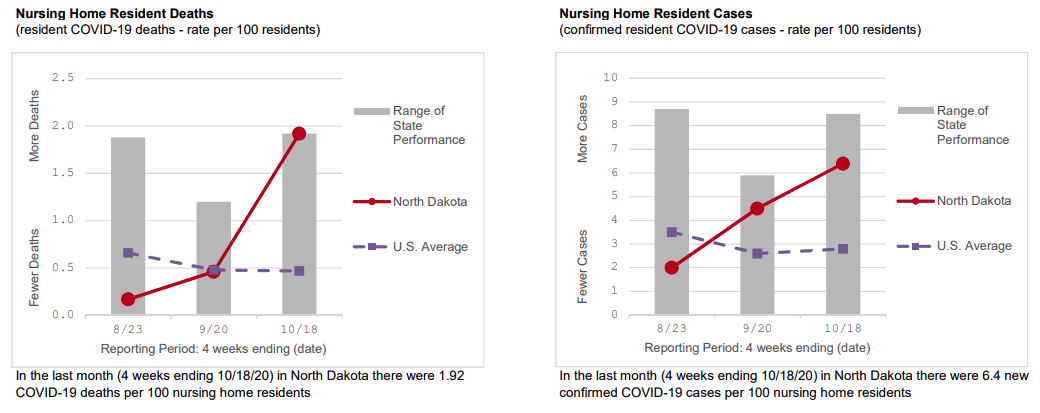AARP Hearing Center

Nursing homes in North Dakota are struggling with the highest rate of COVID-19 deaths among residents in the nation, an exclusive new AARP analysis of recent government data shows.
The state saw resident deaths climb 11-fold, from eight over a four-week period in July and August to 89 over a four-week period in September and October. Over the same period, COVID-19 cases among residents skyrocketed, with 93 monthly infections climbing to 298.
The jump in deaths makes North Dakota home to the highest nursing home death rate in the country, with around 1 in every 50 residents dying from the disease. The result represented a huge shift in the state’s performance compared to AARP’s last analysis, released a month ago, which ranked North Dakota just below the national average for resident deaths.
“Clearly, these trends are going in the wrong direction,” says Joshua Askvig, state director of AARP North Dakota. “This is not the place where you want to rank at the top.”

Studies conducted throughout the pandemic show that staff infected with COVID-19 are one of the greatest drivers of resident infections within nursing homes. Given the high infection and death rates among North Dakotan nursing home residents, it’s perhaps unsurprising that staff infections also skyrocketed, leaping from 165 in July-August to 578 in September-October.
The state also reported the highest staff infection rate in the country; 12.5 staff per every 100 residents tested positive for the disease in September-October. Staff infections were almost double the number of resident infections – 579 cases versus 298 cases, respectively – and were more widespread than resident infections, with more than 90 percent of nursing homes reporting one or more positive tests among staff, while only 47 percent reported resident cases.
With so many of the state’s nursing home staff infected with the virus, it’s also perhaps unsurprising that North Dakota reported the highest percentage of nursing homes with a shortage of nurses, aides (certified nursing assistants, nurse aides, medication aides and medication technicians), or both. Facilities experiencing staffing shortages surged from 35 percent in July-August to 55 percent in September-October.
North Dakota’s high spread of COVID-19 in the broader community is likely a cause of the state’s nursing home infections, according to several nursing home experts. "The virus gets introduced into these facilities through community networks of transmission,” says Justin Lessler, an associate professor of epidemiology at the John Hopkins Bloomberg School of Public Health.
AARP’s Askvig is calling on all North Dakotans to play their part in containing the spread. “We must all follow CDC guidelines — all infection control protocols — to prevent the spread of COVID-19,” he says. “It’s killing people, particularly these vulnerable adults, and it’s easy for people to say, ‘Oh well, these residents are at the end of life anyway.’ But these are grandparents, parents, siblings, loved ones, trusted friends and they have as much of a right as anybody to be safe and protected from the virus.”
Read more about the analysis of North Dakota nursing homes.
The analysis, conducted by AARP's Public Policy Institute and the Scripps Gerontology Center at Miami University in Ohio, draws primarily on data acquired from the Nursing Home COVID-19 Public File by the Centers for Medicare & Medicaid Services (CMS). Nursing homes are federally certified and are required to submit data to the government each week. The AARP analysis uses data from three consecutive four-week periods — July 26 to Aug. 23, Aug. 24 to Sept. 20 and Sept. 21 to Oct. 18 — in which around 95 percent of the nation's 15,000-plus nursing homes submitted data for each reporting period.
The analysis focuses on five key COVID-19 categories — resident cases, resident deaths, supply of personal protective equipment, staff cases and staff shortages — and only captures data from federally certified nursing homes, not all long-term facilities, as some other tallies do. This is the second in a series of monthly AARP analyses. An update on these key COVID-19 categories will be released next month, as new federal data becomes available.































































